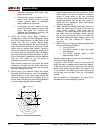
Ridge Tool Company Elyria, Ohio U.S.A www.seektech.com 25
SeekTech SR-60
that the signal falls away on every side of the
maximum signal location.
Note: If following a moving Sonde, it may be
easiest to “chase” a pole, and then to pinpoint the
actual position of the Sonde only after the Sonde
has stopped moving.
Measuring Depth (Sonde Mode)
The SR-60 calculates Measured Depth by comparing
the strength of the signal at the lower antenna to the
upper antenna. Measured Depth is approximate; it will
usually reflect the physical depth when the mast is
held vertical and the bottom antenna is touching the
ground directly above the signal source, assuming no
distortion is present.
1. To measure depth, place the locator on the
ground, directly above the Sonde or the line.
2. Measured Depth will be shown in the lower
left hand corner of the SR-60’s display
screen.
3. Measured Depth will be accurate only if the
signal is undistorted. Measured Depth Display
is disabled under clipping conditions.
Note: Holding the Select Key will display a short
count-down followed by a calculated depth report.
This “Pushbutton Depth”, calculated on more
signal samples, will be more precise than the
running Depth indication. (See Depth Warnings
on page
16).
Clipping (Sonde Mode)
Occasionally the Signal Strength will be strong
enough that the receiver will be unable to process the
entire signal, a condition known as “clipping”. When
this occurs, a warning symbol
will appear on the
screen. It means that the signal is particularly strong.
SimulTrace
The SR-60 has a new capability for use in specialized
locating situations which enables you to trace a
pushcable and a Sonde simultaneously. This
capability is called SimulTrace. When it is activated,
the SR-60 will display a tracing line tuned to 33 kHz at
the same time as it seeks on the 512 Hz frequency for
a Sonde. By following the 33 kHz signal, the locator
can follow the pushcable along a pipe, for example,
and can simultaneously detect the Sonde emitting a
512 Hz signal when it is within detection range.
Some modern pushcable and camera systems are
equipped to inject the 33 kHz signal onto the
pushcable automatically. If you are using an earlier
pushcable and camera system, you can inject the 33
kHz signal onto the pushcable by using an Inductive
Clamp with several turns of the pushcable looped
around the jaws. Plug the Inductive Clamp into a
transmitter set to 33 kHz and turn it on.
To activate the SimulTrace mode, select it from the
Main Menu frequency list and toggle it into Active
Status (it is off by default). Then, select SimulTrace
from the menu of frequencies.
Figure 37: Selecting SimulTrace Mode
Once you have activated the SimulTrace mode, follow
the general rules of active line tracing to find and
follow the pushcable.
When you are within detection distance of the Sonde,
the screen will automatically shift to Sonde mode and
will display the equator and the poles as described
above. When SimulTrace is active, the screen will
continue to display a faint tracing line representing the
pushcable on 33 kHz even when it is in Sonde mode.
This is especially useful if you are following a pipeline
whose location and bearing is questionable. Note: If
no signal from either a line at 33 kHz or a 512 Hz
Sonde can be detected, the magnifying glass will
appear to indicate the unit is seeking for a signal.
Figure 38:
SimulTrace Mode: No-Signal Icon


















